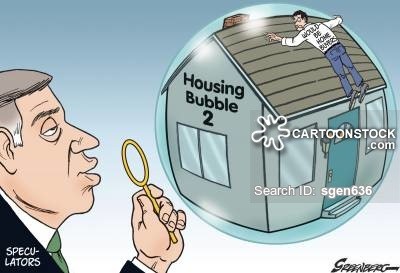An economic bubble can be described as a surge in the market caused by speculation regarding a commodity which results in an explosion of activity in that market segment causing vastly overinflated prices. The prices are not sustainable and the bubble is usually followed by a crash in prices in the affected sector.
From 1986 till 1991 Japan witnessed a bubble economy: its real estate and stock prices were greatly inflated. A bubble is created when uncontrolled money is supplied and market experiences credit expansion. This situation leads to over confident speculation assets and stock prices due to eased money supply policy at that moment.
A ‘’financial bubble’’ refers to a situation where there is a relatively high lev el of trading activity on a particular asset class at price levels that are significantly higher than their inherent values, or built-in values. In other words, a bubble occurs when certain investments are bid up to prices that are far too high to be sustainable in the long run.
el of trading activity on a particular asset class at price levels that are significantly higher than their inherent values, or built-in values. In other words, a bubble occurs when certain investments are bid up to prices that are far too high to be sustainable in the long run.
The 1990s saw ‘’technology bubble’’. Many new dotcom companies were floated in market, and their stocks (share) were bid up to extremely high prices in a relatively short period of time. This bubble was so crazy that even companies that were infant start-ups and had yet to produce actual earnings were bid up to large market capitalizations by speculators attempting to earn a quick profit from the bull market in the technology sector. By 2001 however, the technology bubble burst and many of these formerly high-flying stocks came crashing down to drastically lower price levels. Bubbles at time are insane, and they crash down rumbling.
Another noteworthy bubble was the ‘’housing bubble’’ that occurred after the technology bubble; this was characterized by an initial increase in housing prices due to fundamentals; the fundamental can be described as often, homeowners make the harmful error of assuming recent price performance will continue into the future without first considering the long-term rates of price appreciation. As the bull market in housing continues, many investors begin buying homes as speculative investments, and this unsustainable run-up in housing prices eventually come crashing down badly. The United States housing bubble was responsible for the ‘subprime crisis’, which affected over half of the United States. Housing prices peaked in early 2006, started to decline in 2006 and 2007, and reached new lows in 2012.
A real estate bubble is a type of economic bubble that occurs periodically in local, regional, national or global real estate markets. In the stock market, booms are associated with bull markets (where investors are optimistic that stocks will go up) whereas the busts (break) are associated with bear markets.
What is a ‘Boom’? Stocks that suddenly become very popular and gain strong, elevated market profits are the result of a stock boom. A company or industry boom results in an increase of output, jobs and investment in that industry. Certain events can be citywide or nationwide booms for business activity, such as hosting the Olympics, which translates into capital investment, TV broadcasting deals, sponsorship deals and tourism. For example, TV broadcasting revenue alone was projected to be $4.1 billion for the 2016 Summer Olympics in Brazil.
On the other hand, a downturn in a particular industry or financial sector can result in a bust for an entire city or state, especially if the region has invested too heavily in that industry or sector. Arizona and Nevada are currently mired in an economic slump because they were hit hardest by the real estate bust due to the subprime crisis of 2007-08.
Booms are not essentially sustainable; but when they end, things level out, the industry experiences a minor setback. When a Bubble ends, a significant number of people experience serious economic hardships. That’s the difference between bubble and boom. Okay, a boom is what you call a bubble before it bursts.
On a serious note, a bubble is a situation when one particular thing becomes overvalued. Think back to the 90’s. There were some really successful internet start-ups like Google, Amazon, Ebay, etc. Investors went absolutely insane giving any idiot with an internet company a ton of money to invest in their business. Those businesses became worth a ton of money overnight. Eventually, people realized that many of those companies were not particularly profitable, and pulled out their money. It was a kind of the bubble burst. Overnight those companies went from being wildly expensive to be being completely valueless.
A boom on the other hand is a normal thing. It is like there is a huge demand for a product such as herbal products, especially in towns where there are no herbal product shops; the marketer expands demand for the products through shops from other town. Everyone loves the product, so the demand increases hence many other herbal companies also open shops. This part is the boom. The post–World War II economic expansion, also known as the post-war economic boom, the long boom, and the Golden Age of Capitalism, was a period of economic prosperity in the mid-20th century which occurred, following the end of World-War II in 1945, and lasted until the early 1970s.
Economic booms are helpful for market expansions. Expansion Strategy is adopted by organizations when they attempt to achieve a high growth as compared to its past achievements. For example, let’s talk about one restaurant owner who grew his business by adding a private catering service. He also adds a third dimension of selling signature dessert items through local grocery stores. Fourth – he adds a grocery store of his own to his business expansion.
The cyclical nature of the market and the economy in general suggests that every strong economic growth happens in bull market which follows by a sluggish low growth bear market. Usually bubbles start with some good economic reasons.
Some factors that cause bubbles:
Illogical enthusiasm: In certain circumstances, investors buy assets because of strong psychological pressures which encourage them to ignore the fundamental value of the asset and believe that prices will keep rising.
Herd mentality: People often assume the majority can’t be wrong. If prominent and well-established financial leaders are buying, they assume it must be a good investment.
Short term perspective: People make decisions based on short term thinking rather than the long-term.
Adaptive expectations: People often judge the state of a market and economy by what has happened in the recent past. They hope they can beat the market and hence they decide to buy and then get out before the bubble bursts.
Cognitive dissonance: It refers to filtering out bad news and looking for views which reinforce our beliefs. People often do it; they look out for views from market which suits their pre or post buying decision.
















































